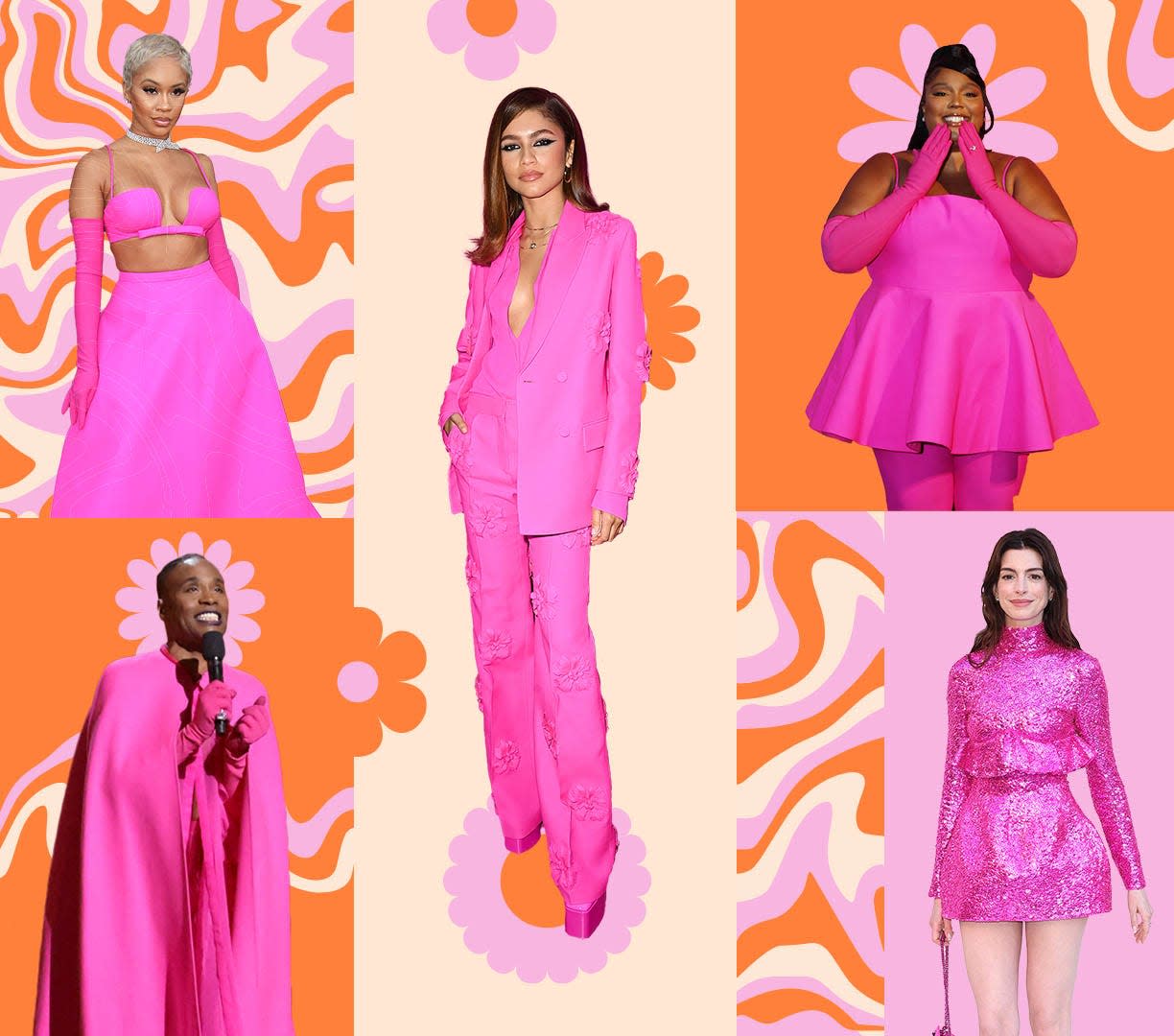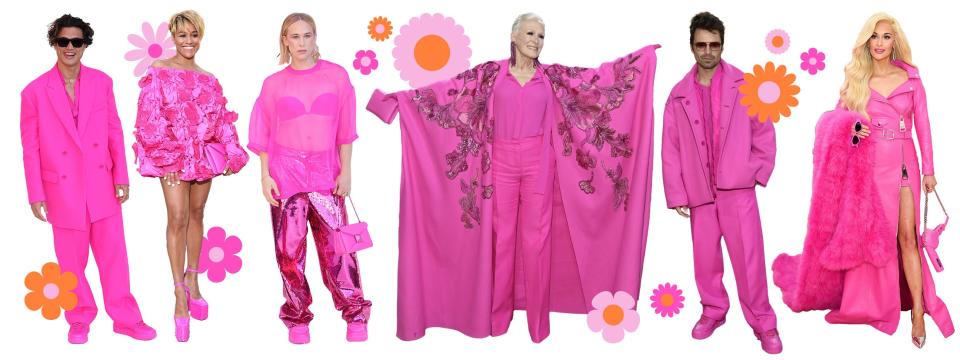Who gets to be a Barbie doll? New all-pink Barbiecore trend invites everyone to the Dream House

Hot pink is the new black.
Barbie is back in the cultural zeitgeist and hot pink fashion is all the rage this summer: Stars from Lizzo and Anne Hathaway to Ziwe, Glenn Close, Sebastian Stan and Billy Porter have stepped out rocking all-pink looks, reminiscent of America's favorite doll.
Goodbye muted millennial pink, hello Barbie-inspired hot pink. The reign of the rose quartz Pantone dubbed one of its colors of the year in 2016 is over, ushering in a bolder, brighter neon pink that's making waves.
Fashion has long inspired and been inspired by the childhood doll, and it's making a comeback as a style muse in 2022 as interest increases around the Barbiecore trend, emphasizing fun, often over-the-top looks usually reserved for a Barbie doll.
"People feel more empowered to wear more daring shades of pink rather than that muted millennial pink shades that we had embraced before," says fashion executive CeCe Vu. "It's more of a statement showcasing feminine strength."
Shop like Barbie: Rock the Barbiecore trend with these bright pink styles

Where did Barbiecore come from?
Seeing an influx of hot pink platform heels, sassy hairstyles and fun accessories on your Instagram feed? There are a few reasons why.
The internet blows up every time a new image from the set of Greta Gerwig's upcoming "Barbie" movie surfaces. Margot Robbie and Ryan Gosling are tapped as Barbie and Ken, in all their blonde, neon clothing glory.
Meanwhile, the fashion world is all about hot pink, especially thanks to Valentino creative director Pierpaolo Piccioli's signature shade of pink. The fashion brand's Paris Fashion Week show in March, which featured monochrome pink runway looks and a slew of celebrities dressed on theme, was a major starting point for today's Barbiecore theme, fashion experts say.

Other high fashion brands including Prada and Versace have also incorporated hot pink designs into their collections. And now the trend has been trickling down to department stores and fast fashion brands (see: Meryl Streep's infamous cerulean sweater monologue from "The Devil Wears Prada"). In online retailing, searches for pink mini dresses have increased by 970% and pink swimsuits 682% in the last six months, according to ecommerce platform Klarna.
The beauty world has seen a surge in pink-forward makeup looks too, notes Gianluca Russo, author of "The Power of Plus." And Vu highlights brightly-colored home decor trends becoming increasingly popular over the last few months.
"In the early stages of the pandemic, people would say there's always a renaissance after a moment like this," Russo says. "This is the fashion renaissance happening: this very fast pivot from the dark era to something that's bright and youthful and colorful."
Barbie’s complicated history in fashion and beauty
For most of Barbie's 63-year history, she has represented a very specific and largely unattainable demographic.
"She was supposed to be this sort of feminine ideal," says longtime business of culture journalist Christina Binkley. "And then that turned around and and people started to see her as representative of sort of anti-feminist with this absurd body shape."
When Malibu Barbie was introduced in the early '70s, she represented that ultra-thin, white, blonde beauty standard. Half a century later, everyone gets to dress up and feel like Barbie.
Mattel, Barbie's parent company, has worked to revamp the doll's image over time. Now, dolls come in a variety of body types, skin colors, physical abilities and career paths. Malibu Barbie is still for sale, but so are Rosa Parks, Jane Goodall, and Laverne Cox Barbies.
Though the fashion world is channeling the Malibu Barbie aesthetic, it's more whimsical and inclusive as adopters have fun with the trend, at times bordering on camp.
"There's a lightheartedness to it," Binkley says. "We're ready to laugh at Barbie and not take her too seriously."
That lightheartedness also highlights confidence. To Vu, dressing in Barbiecore means "you feel empowered and comfortable in your own skin. You love yourself. You're not afraid to express what you want and what you stand for."
‘Be who you want to be’
At the, well, core of Barbiecore is reinvention, as "people are taking it for themselves and making it their own," Binkley says.
"When I was a child people found the Barbie image kind of intimidating, because it was impossible to live up to it. ... I don't know that people take it seriously now. I'm sure there are many people who resent the Barbie image. There's (still) plenty to resent there. But I think also women are a bit more confident about having flaws and giving them permission to sort of expose their flaws more than than they did in previous previous eras."

Lizzo, who sported Valentino pink from head to toe at the June premiere of her Amazon Prime show "Lizzo's Watch Out For the Big Grrrls," is known for spreading body positivity and pushing the fashion industry to be more inclusive to plus-size bodies. The "About Damn Time" singer's perfect encapsulation of the Barbiecore energy shows just how fashion lovers are claiming the trend, regardless of who Barbie was orginally designed to represent.
"For so long, designers kept it limited to only certain body types to represent us only certain types of people," Russo says. "To see someone like Lizzo now wear Valentino, and to be a part of this trend in this moment. She feels like she opened this door for us to be included. … It's always an exciting moment when you get to see someone who lives in a larger body partake in the hottest trend in fashion."
Piccioli told British Vogue he saw the all-pink Paris Fashion Week show as an opportunity to celebrate individuality.
“You know when you see a book of black and white portraits, after two or three pages you know it’s a black and white portrait book, so you don’t expect to see blonde hair and blue eyes?" he said. "You go deeper into the faces: who they are, and not what they represent. When you see only pink, you get them."
Barbiecore's essence is an amalgamation of 2022: an escape from chaos, an expression of self and a celebration of differences.
"I think people are now saying 'we love that Barbie aesthetic and now we're gonna apply it to who we really are and what we really look like and not try to shrink down to fit it, but we're going to size it up so that it fits us,' " Russo says of the "spectrum of Barbie."
"Everyone can wear the pink, it's not only for people who wear a size 2 or or who are white and rich. Anyone can wear this style."
This article originally appeared on USA TODAY: Barbiecore trend: All pink clothing is summer's hottest look
